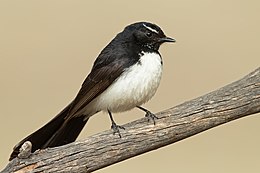Our website is made possible by displaying online advertisements to our visitors.
Please consider supporting us by disabling your ad blocker.
Willie wagtail
| Willie wagtail | |
|---|---|

| |
| In the Glen Davis, New South Wales, Australia. | |
| Scientific classification | |
| Domain: | Eukaryota |
| Kingdom: | Animalia |
| Phylum: | Chordata |
| Class: | Aves |
| Order: | Passeriformes |
| Family: | Rhipiduridae |
| Genus: | Rhipidura |
| Species: | R. leucophrys
|
| Binomial name | |
| Rhipidura leucophrys (Latham, 1801)
| |
| Subspecies | |
|
R. l. leucophrys | |

| |
| Willie wagtail range[image reference needed] | |
The willie wagtail (also spelt willy wagtail), scientific name Rhipidura leucophrys, is a passerine bird native to Australia, New Guinea, the Solomon Islands, the Bismarck Archipelago, and Eastern Indonesia. It is a common and familiar bird throughout much of its range, living in most habitats apart from thick forest. Measuring 19–21.5 cm (7+1⁄2–8+1⁄2 in) in length, the willie wagtail is contrastingly coloured with almost entirely black upperparts and white underparts; the male and female have similar plumage.
Three subspecies are recognised; Rhipidura leucophrys leucophrys from central and southern Australia, the smaller R. l. picata from northern Australia, and the larger R. l. melaleuca from New Guinea and islands in its vicinity. It is unrelated to the true wagtails of the genus Motacilla; it is a member of the fantail genus Rhipidura and is a part of a "core corvine" group that includes true crows and ravens, drongos and birds of paradise. Within this group, fantails are placed either in the family Dicruridae, alongside drongos, or in their own small family, Rhipiduridae.
The willie wagtail is insectivorous and spends much time chasing prey in open habitat. Its common name is derived from its habit of wagging its tail horizontally when foraging on the ground. Aggressive and territorial, the willie wagtail will often harass much larger birds such as the laughing kookaburra and wedge-tailed eagle. It has responded well to human alteration of the landscape and is a common sight in urban lawns, parks, and gardens. It is widely featured in Aboriginal folklore around Australia and New Guinea in a variety of roles, from stealer of secrets and liar to a good omen for successful crops.[2][3][4]
- ^ BirdLife International (2017). "Rhipidura leucophrys". IUCN Red List of Threatened Species. 2017: e.T22706805A118756017. doi:10.2305/IUCN.UK.2017-3.RLTS.T22706805A118756017.en. Retrieved 11 November 2021.
- ^ Cite error: The named reference
Topendwas invoked but never defined (see the help page). - ^ Cite error: The named reference
Boles384was invoked but never defined (see the help page). - ^ Majnep, Ian Saem; Blumer, Ralph (1977). Birds of my Kalam Country. Auckland: Auckland University Press. pp. 103–04. ISBN 0-19-647953-3.
Previous Page Next Page



